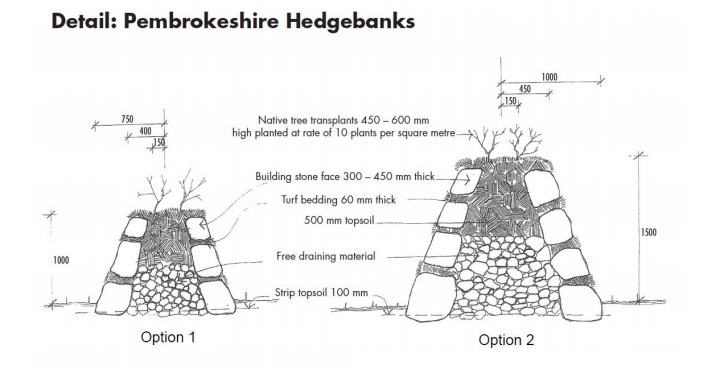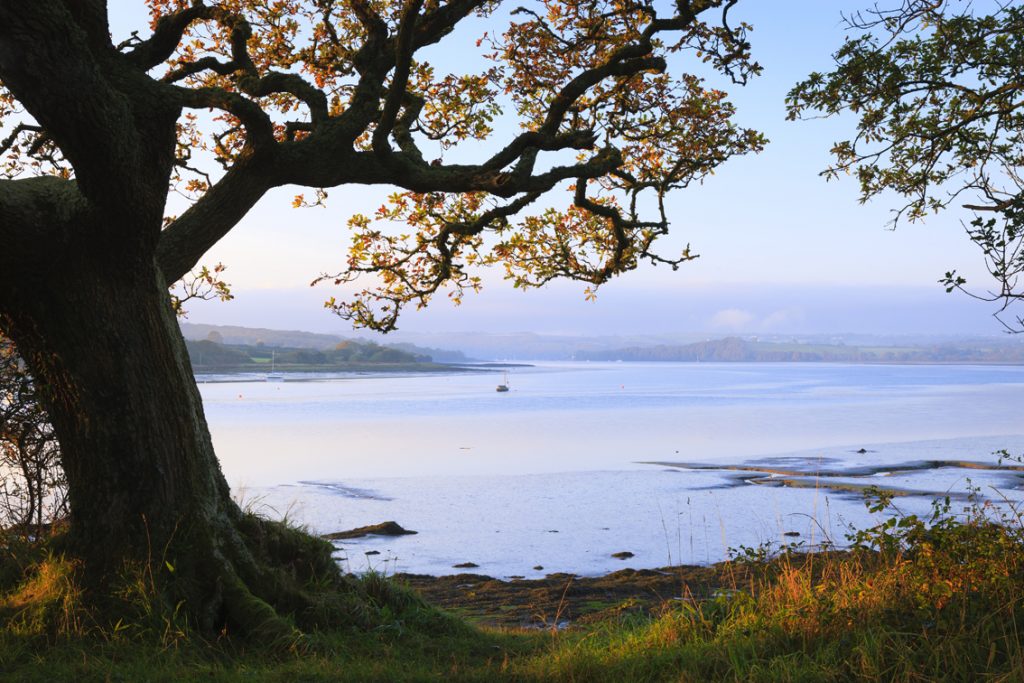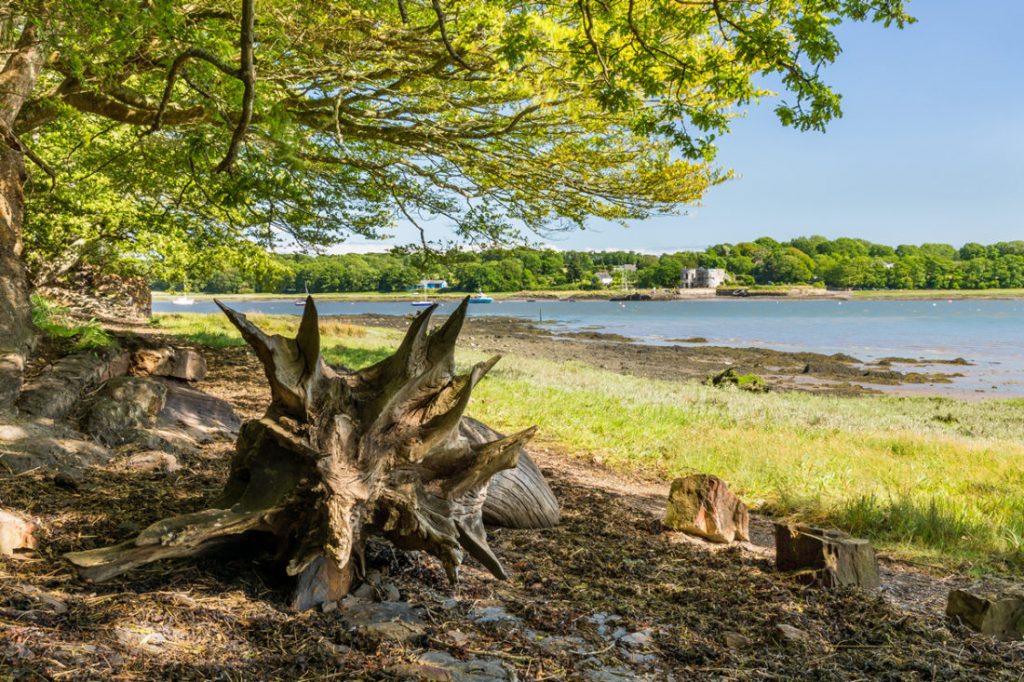Advice note – Hedge and Boundary planting
General planting advice
- The use of an increased variety of species as part of the hedge planting will ensure long term success that will not be as susceptible to pests and diseases as mono-species hedges.
- A native hedge will produce a native structure that is beneficial to nature as well as providing a substantial screen and boundary.
- The planting of deciduous native species will also allow more passive light through the structure in the winter than an evergreen structure.
- A standard native hedge should have 6 plants per metre in two staggered rows about 25cm apart (or 40-60cm apart in each row).
- Do not use plants that are too small as they can become swamped by weeds: 60-90cm tall is normally sufficient
- Smaller specimens can be considered in gardens where maintenance is carried out more often to prevent weeds and grasses competing with the planted specimens. However if the area is not under regular maintenance a taller specimen would be advised.
- In exposed situations staking with canes may be needed. If there is a risk of rabbit predation, use spiral guards or an equivalent method of protection.
- The best time for planting is:
- Cell grown stock – September to May
- Bare root stock – November to end of March – During this time you can buy bare rooted plants which are cheaper than pot / cell grown. Note: Damp, overcast weather is preferable for planting; avoid planting on sunny, windy days, periods of hard frosts and/or when snow is on the ground.
Species selection
- A predominant native Pembrokeshire hedge species would be Hawthorn (50-60%) along with Blackthorn and Hazel. This will ensure the establishment of a native hedge with less vulnerability to pests and diseases which is an increased risk in mono-species hedges.
- Blackthorn is a key species in Pembrokeshire hedges however it is generally on Pembrokeshire hedge banks where the lateral root spread of the planted species can limit the invasive nature. Where Blackthorn is planted as a hedge and not on a bank it can encroach into open areas such as fields or gardens adjacent to the hedges in question. Where the adjacent land and hedge is regularly managed this may not be an issue but should still be taken under consideration where it is the proposed predominant species.
- The inclusion of species such as Spindle, Dogwood and Guelder rose can also be considered to increase diversity.
- If evergreen varieties are required, the use of native species such as Holly and Wild privet can be considered.
- The following species list are trees or shrubs native to Pembrokeshire that are suitable for hedging.
| Gorse** | Ulex europaeus/gallii | Spindle | Euonymus europaeus |
| Blackthorn | Prunus spinosa | Wayfaring tree* | Viburnum lantana |
| Crab Apple* | Malus sylvestris | Wild privet | Ligustrum vulgare |
| Guelder rose | Viburnum opulus | Elder | Sambucus nigra |
| Hawthorn* | Crataegus monogyna | Dogwood | Cornus sanguinea |
| Hazel | Corylus avellana | Dog Rose (climber) | Rosa canina |
| Holly* | Ilex aquifolium |
* These species can also be grown into small trees within the hedge.
** Found in very exposed sites
- Larger trees such as Oak can also be planted if required. Ash is a native species found on hedges; however it would be advised that Ash is omitted from planting schemes at this time. Refer to the Plant Health (Wales) (Amendment) Order 2013.
- Elder can grow quicker than other hedgerow species and as such is recommended for inclusion once the hedge has begun to establish as it is beneficial to wildlife due to flower and berry production. If the aim of the hedge is a stock proof structure then Elder may not be suitable; due to its brittle nature producing a ‘weak link’.
- Once established the inclusion of ‘climber’ species such as Dog Rose, Honeysuckle and Climbing Rose could be considered to increase diversity as well as adding additional lateral strength and cohesion to the hedgerow. It is advised that the hedge is given time to establish first to prevent climbers dominating young shrubs.
Planning Application information
Planning applications – Where a post development landscaping scheme is required or proposed; details of the hedge planting should be provided, including:
- Species proposed within the hedge
- Size – height of specimens when planted
- Form – feathers, whips, and any standards to be included
- Number of each species to be planted or percentage
- Specific locations – which boundary etc
- Spacing – double staggered etc
- Local provenance – if known
- Time of planting
- Any other relevant information – bare-root, cell grown, containerised
The simplest way to provide the necessary information is in the form of a table:
| Name | Latin Name | No | % | Spacing | Size |
| Blackthorn | Prunus spinosa | 12 | 20% | 6 plants per metre – 2 staggered rows | 60-90cm |
| Wild privet etc | Ligustrum vulgare | 3 | 5% | 6 plants per metre – 2 staggered rows | 60-90cm |
Non-native / Invasive species
- Care should be taken to ensure where possible that native species (of local provenance) are used so as to prevent establishment or encroachment of non-native species into the surrounding area.
- It is also be necessary to ensure that any species selected are not listed in Schedule 9 of the Countryside and Wildlife Act 1981.
Pembrokeshire Hedgebanks
- If Pembrokeshire Hedgebanks are proposed on site; details of the construction method including dimensions should also be provided in any planning application.
- Pembrokeshire Hedgebank features as structures within proposed development are preferable features in Pembrokeshire as they:
- Can be implemented to provide an immediate structure that softens the development area.
- Minimise the risk of tree failure can occur in development sites through compaction of ground / physical damage (direct impacts from vehicles) / chemical damage (fuel spillage/road salt) / maintenance obligations / future nuisance from trees requiring management for height and spread clearances.
- Provide immediate native screening that will allow less management responsibilities as the hedge and occasional trees species will be growing at an elevated height with less spread; all reducing the frequency to carry out remedial pruning for clearances.
- Reduce the risk of surface damage through incremental root development into the development area as the establishment of the root system occurs predominantly within the hedgebank.
- Provide a level of connectivity and habitat interest; where efforts are made to ensure they are contiguous with the adjacent landscape.
- Are a traditional landscape feature of Pembrokeshire; providing an historical landscape link to the site.
- Allow a simpler management of hedge features through pruning of the entire hedgerow at intervals to benefit wildlife and site usage and selective management of any feature trees planted on the banks.
- Examples of typical Pembrokeshire hedgebank construction types are shown:

Advice and downloads
Advice note - Hedge and boundary planting
The use of an increased variety of species as part of the hedge planting will ensure long term success that will not be as susceptible to pests and diseases as mono-species hedges.

